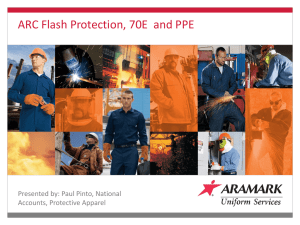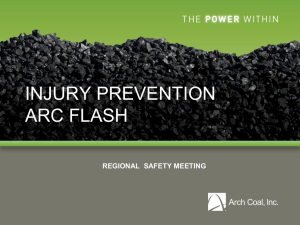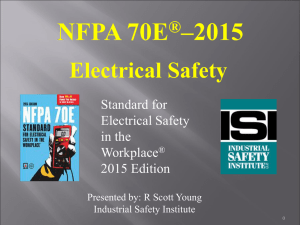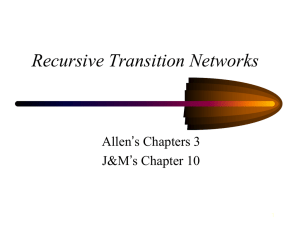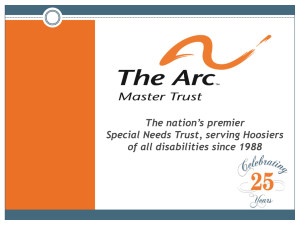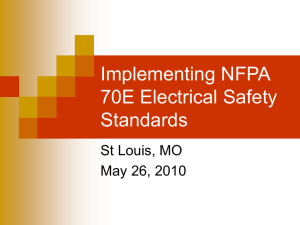Arc Flash Protection - Effect on Lineman
advertisement
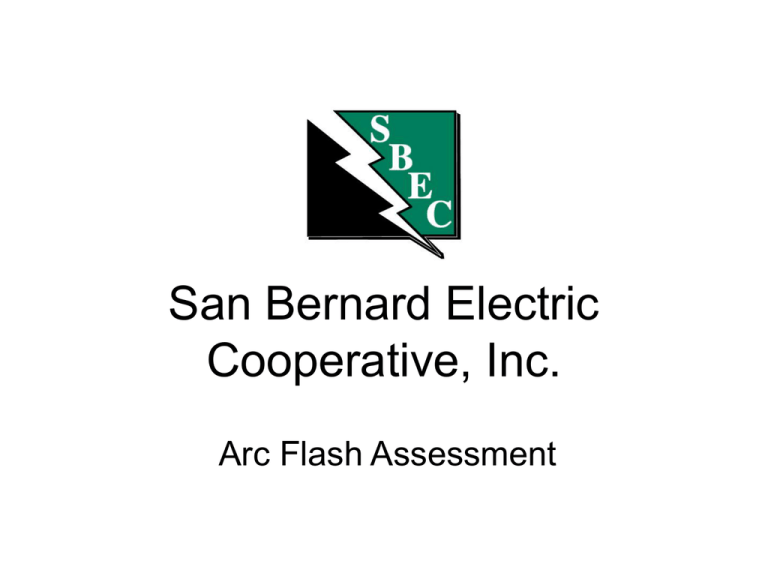
San Bernard Electric
Cooperative, Inc.
Arc Flash Assessment
What Is An Arc Flash?
• An Arc Flash is the result of a rapid release of
energy due to an arcing short circuit between
two or more adjacent conductors.
• The cause of the short normally burns away
during the initial flash, and the arc fault is then
sustained by the establishment of a highlyconductive plasma.
• The plasma will conduct as much energy as is
available and is only limited by the impedance of
the arc.
•Electric arcs produce the highest temperatures on
earth –up to 35,000 degrees Fahrenheit
•The intense heat from arc causes the sudden
expansion of air that results in a blast with very
strong air pressure (Lightning is a natural arc).
•All known materials are vaporized at this
temperature. (Copper expands 67,000 times,
Water 1670 times).
•Arcs in enclosures, such as a Motor Control
Centers (MCCs) or switchgear, magnify blast
and energy transmitted as the blast is forced to
the open side of the enclosure.
• Arcs spray droplets of molten metal at highspeed (700 mph) pressure. Blast shrapnel can
penetrate the body.
•Blast pressure waves have thrown workers
across rooms and knocked them off ladders.
Pressure on the chest can be higher than 2000
lbs/ sq. ft.
•Clothing can be ignited several feet away unless
flame-resistant clothing is used. Arc Flashes have
caused death as far away as 10 ft.
•Hearing loss from sound blast. The sound can
have a magnitude as high as 160 dB.
Why all the interest ?
Federal Law
• OSHA 1910, 1926
National Consensus Standards
•
•
•
•
NFPA 70 – National Electric Code ®
NFPA 70E – Standard for Safety in the Workplace
®
NESC – National Electric Safety Code
IEEE 1584 – Guide for Arc Flash Hazard Analysis
Consensus Standards
• NFPA-70 - Generally applies to construction &
installation
• OSHA requested NFPA to create a standard to address
worker safety …. result was NFPA-70E
• Arc flash appeared in NFPA-70E as a “recognized
hazard” in 1995. NFPA-70E excludes “utilities” {90.1(5)}
• NESC identified arc flash as a “recognized hazard“ in
2007 and closed the utility loop-hole {410.A.3}
• IEEE 1584 created to develop a standard for quantifying
the dangers associated w/ arc flash
OSHA – General Duty Clause
“Each employer shall furnish to each of his
employees employment and a place of
employment which are free from recognized
hazards that are causing or are likely to cause
death or serious physical harm to employees.”
Law or not??
2007 NESC Rule 410.A.3
• Effective as of January 1, 2009, the employer shall
ensure that an assessment is performed to determine
potential exposure to an electrical arc for employees who
work on or near energized parts or equipment. If the
assessment determines a potential exposure greater
than 2 cal/cm2 exists (see Neal, Bingham, and Doughty
[B53]), the employer shall require employees to wear
clothing or a clothing system that has an effective arc
rating at least equal to the anticipated level of arc
energy.
Adopted by State of Texas
How do you protect workers?
• Work on equipment only after being
placed in an electrically safe condition.
• If the equipment must be worked live:
PPE
Proper safety training / procedures
Maximize working distance
Minimize fault clearing time
PPE
• PPE is intended to reduce skin damage to
second degree burns only. Second degree
burns are considered to be “just curable”.
• 1.2 Calories / cm2 is generally considered to be
threshold of a second degree burn.
• Workers can still be burned by following the
rules and using the “correct” PPE.
• Is FR equipment considered PPE?
Arc Flash Energy
Contributing Factors Include:
•
•
•
•
•
•
Available fault current
Distance to arc flash
Time exposed to arc flash
Location (open-air, enclosure, etc)
System grounding
System voltage / conductor gap
Personal Protective Clothing
Examples of PPE
Hazard Risk
Category 0
Hazard Risk
Category 1
Hazard Risk
Category 2
Hazard Risk
Category 3
Hazard Risk
Category 4
2012 NESC Rule 410.A.3
If the assessment determines a potential employee
exposure greater than 2 cal/cm2 exists, the employer
shall:
b. Require employees to wear clothing or a clothing
system with an effective arc rating not less than the
anticipated level of arc energy.
EXCEPTION 1: If the clothing required by this rule has
the potential to create additional and greater hazards
than the possible exposure to the heat energy of the
electric arc, then clothing with an arc rating or arc
thermal performance value (ATPV) less than that
required by the rule can be worn.
2007 NESC Rule 410.A (cont.)
4. Employers shall utilize positive procedures to secure
compliance with these rules. Cases may arise where the
strict enforcement of a particular rule could seriously
impede the safe progress of the work; in such cases the
employee in charge of the work should make a
temporary modification to the particular rule so the work
can be accomplished without increasing the hazard.
5. If a difference of opinion arises with respect to the
application of these rules, the decision of the employer
or the employer’s authorized agent shall be final. This
decision shall not result in any employee performing
work in a manner that is unduly hazardous to the
employee or to other workers.
